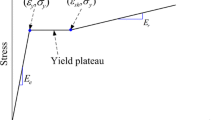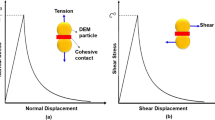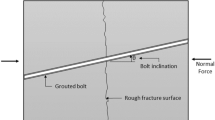Abstract
The mechanical performance of fully grouted rock bolts is essential in the stability of underground excavations in jointed rock masses. This research implements a new cohesive contact model in distinct element codes (PFC2D) to investigate the fracturing response of rock-like and grout material, as well as the bolt–grout interface. The results are compared in detail with experimental observations. The proposed modelling approach, used in conjunction with the distinct element method (DEM), successfully predicted the behaviour of grout failure and the bolt–grout interface’s shear response. We then developed a novel numerical, stepwise pull-and-shear test (SPST) scheme to further analyse the mechanical behaviour of bolted rock joints subjected to simultaneous pull–shear loading. The cohesive DEM framework proposed in this paper was used to carry out the SPST scheme numerically. The mechanism involved in enhancing the shear strength of bolted rock joint was determined by monitoring the \( \sigma_{\text{n}}^{\text{i}} \) and its corresponding contact chain force network during the pull-out test. The influence of pretension stress, the rig angle of the bolt profile, and the constant normal stiffness (CNS) condition are assessed systematically. In particular, the pretension stress magnitude at which the synthetic rock bolting system exhibits the highest shear resistance is identified. The findings from this research highlight the sensitivity of bolted rock joints to the simultaneous pull-and-shear loading, boundary conditions, and bolt–grout interface configurations.


















Similar content being viewed by others
Abbreviations
- CCM:
-
Cohesive contact model
- CNL:
-
Constant normal load
- CNS:
-
Constant normal stiffness
- CSJM:
-
Cohesive smooth-joint model
- DEM:
-
Distinct element method
- DLL:
-
Dynamic link library
- JRC:
-
Joint roughness coefficient
- SJM:
-
Smooth joint model
- SPST:
-
Stepwise pull-and-shear test
- \( \varvec{u}^{\text{p}} \) :
-
Relative displacement
- \( \varvec{u}^{\text{e}} \) :
-
Relative elastic displacement
- \( \varvec{u}^{\text{p}} \) :
-
Relative plastic displacement
- \( \sigma_{\text{n}} \) :
-
Contact normal stress
- \( \sigma_{\text{s}} \) :
-
Contact shear stress
- \( k_{\text{n}}^{0} \) :
-
Contact normal stiffness
- \( k_{\text{s}}^{0} \) :
-
Contact shear stiffness
- \( u_{\text{n}}^{\text{p}} \) :
-
Total normal plastic displacement
- \( u_{\text{s}}^{\text{p}} \) :
-
Total shear plastic displacement
- \( F \) :
-
Yield function
- \( C \) :
-
Cohesion of contact
- \( C^{0} \) :
-
Initial cohesive of contact
- \( \mu \) :
-
Friction coefficient of contact
- \( \kappa \) :
-
Softening parameter
- \( u^{\text{p}} \) :
-
Accumulated plastic displacement of contact
- \( D \) :
-
Damage parameter
- \( G \) :
-
Plastic potential
- \( \beta \) :
-
Dilation coefficient of contact
- \( d\lambda \) :
-
Plastic multiplier
- \( \sigma_{\text{n}}^{\text{trial}} \) :
-
Trial normal stress of contact
- \( \sigma_{\text{s}}^{\text{trial}} \) :
-
Trial shear stress of contact
- \( F^{\text{trial}} \) :
-
Trial yield function
- \( \bar{A} \) :
-
Cross-sectional area of contact
- \( \bar{R} \) :
-
Radius of DEM particle
- \( \overline{{E_{\text{c}} }} \) :
-
Elastic modulus of contact
- \( L \) :
-
Contact length
- \( k^{*} \) :
-
Normal-to-shear stiffness ratio of contact
- υ:
-
Poisson’s ratio
- \( r_{ \hbox{max} } \) :
-
Maximum radius of DEM particle
- \( r_{ \hbox{min} } \) :
-
Minimum radius of DEM particle
- \( \alpha \) :
-
Rib angle
- \( \bar{E}_{c,CCM} \) :
-
CCM elastic modulus
- \( C_{\text{CCM}}^{0} \) :
-
CCM initial cohesion
- \( \mu_{\text{CCM}} \) :
-
CCM friction coefficient
- \( \beta_{\text{CCM}} \) :
-
CCM dilation coefficient
- \( k_{\text{CCM}}^{*} \) :
-
CCM normal-to-shear stiffness ratio
- \( \kappa_{\text{CCM}} \) :
-
CCM-softening parameter
- \( D_{\text{CCM}} \) :
-
CCM damage parameter
- \( k_{\text{n}}^{\text{sj}} \) :
-
Normal stiffness of SJM contact
- \( k_{\text{s}}^{\text{sj}} \) :
-
Shear stiffness of SJM contact
- \( \mu^{\text{sj}} \) :
-
Friction coefficient of SJM contact
- \( k_{\text{s,CSJM}}^{0} \) :
-
CSJM shear stiffness
- \( k_{\text{n,CSJM}}^{0} \) :
-
CSJM normal stiffness
- \( C_{\text{CSJM}}^{0} \) :
-
CSJM initial cohesion
- \( \mu_{\text{CSJM}} \) :
-
CSJM friction coefficient
- \( \beta_{\text{CSJM}} \) :
-
CSJM dilation coefficient
- \( \kappa_{\text{CSJM}} \) :
-
CSJM-softening parameter
- \( D_{\text{CSJM}} \) :
-
CSJM damage parameter
- \( \lambda \) :
-
Wavelength of idealised rock joint
- \( \sigma_{\text{n}}^{0} \) :
-
Applied normal stress in CNL direct shear test
- \( \sigma_{\text{c}} \) :
-
Rock compressive strength
- \( \sigma_{\text{n}}^{\text{i}} \) :
-
Induced normal stress on rock joint interface
- \( {\text{d}}\sigma_{\text{n}} \) :
-
Change in the normal stress during CNS direct shear test
- \( k^{\text{cns}} \) :
-
CNS stiffness
- \( {\text{d}}\delta_{\text{n}} \) :
-
Change in the normal displacement of rock joint
- \( \sigma_{\text{n}}^{\text{u}} \) :
-
Updated normal stress in CNS direct shear test
- \( \sigma_{\text{n}}^{\text{total}} \) :
-
Applied normal stress in pull-and-shear test
References
Aziz N, Jalalifar H, Concalves J (2006) Bolt surface configurations and load transfer mechanism. In: Aziz, Keilich (eds) Proceedings of 7th underground coal operators conference, coal 2006. Wollongong, 5–7 July, pp 236–244. http://www.ro.uow.edu.au/coal/51/
Bahaaddini M (2014) Numerical study of the mechanical behaviour of rock joints and non-persistent jointed rock masses. PhD thesis, The University of New South Wales, Sydney, Australia
Bahaaddini M, Sharrock G, Hebblewhite B (2013) Numerical direct shear tests to model the shear behaviour of rock joints. Comput Geotech 51:101–115
Bahrani N, Kaiser PK, Valley B (2014) Distinct element method simulation of an analogue for a highly interlocked, non-persistently jointed rockmass. Int J Rock Mech Min Sci 71:117–130. https://doi.org/10.1016/j.ijrmms.2014.07.005
Bandis SC, Lumsden AC, Barton NR (1983) Fundamentals of rock joint deformation. Int J Rock Mech Min Sci Geomech Abstr 20:249–268. https://doi.org/10.1016/0148-9062(83)90595-8
Bewick RP, Kaiser PK, Bawden WF (2014a) Shear rupture under constant normal stiffness boundary conditions. Tectonophysics 634:76–90. https://doi.org/10.1016/j.tecto.2014.07.016
Bewick RP, Kaiser PK, Bawden WF, Bahrani N (2014b) DEM simulation of direct shear: 1. rupture under constant normal stress boundary conditions. Rock Mech Rock Eng 47:1647–1671. https://doi.org/10.1007/s00603-013-0490-8
Bjurstrom S (1974) Shear strength of hard rock joint reinforced by grouted untensioned bolts. In: Proceedings of the International Congress of Rock Mechanics, Denver, pp 1194–1199
Cao C, Ren T, Cook C, Cao Y (2014) Analytical approach in optimising selection of rebar bolts in preventing rock bolting failure. Int J Rock Mech Min Sci 72:16–25. https://doi.org/10.1016/j.ijrmms.2014.04.026
Chen Y, Li C (2015a) Influences of loading condition and rock strength to the performance of rock bolts. Geotech Test J 38:208–218. https://doi.org/10.1520/GTJ20140033
Chen Y, Li CC (2015b) Performance of fully encapsulated rebar bolts and D-Bolts under combined pull-and-shear loading. Tunn Undergr Space Technol 45:99–106. https://doi.org/10.1016/j.tust.2014.09.008
Chen N, Zhang X, Jiang Q, Feng X, Wei W, Yi B (2018) Shear behavior of rough rock joints reinforced by bolts. Int J Geomech 18:04017130. https://doi.org/10.1061/(ASCE)GM.1943-5622.0001048
Cundall P, Strack O (1979) A discrete numerical model for granular assemblies. Geotechnique 29:47–65
Dey A (2001) Shear behaviour of fully grouted bolts under constant normal stiffness condition. PhD thesis, University of Wollongong, NSW, Australia
Dight PM, Chiu HK (1981) Prediction of shear behaviour of joints using profiles. Int J Rock Mech Min Sci Geomech Abstr 18:369–386. https://doi.org/10.1016/0148-9062(81)90002-4
Feng S, Liu X, Chen H, Zhao T (2018) Micro-mechanical analysis of geomembrane-sand interactions using DEM. Comput Geotech 94:58–71
Ferrero AM (1995) The shear strength of reinforced rock joints. Int J Rock Mech Min Sci Geomech Abstr 32:595–605. https://doi.org/10.1016/0148-9062(95)00002-X
Gao F, Kang H (2017) Experimental study on the residual strength of coal under low confinement. Rock Mech Rock Eng 50:285–296. https://doi.org/10.1007/s00603-016-1120-z
Gilbert D, Mirzaghorbanali A, Li X, Rasekh H, Aziz N, Nemcik J (2015) Strength properties of fibre glass and other polymer based dowels for strata reinforcement in coal mines. In: Coal operators’ conference. University of Wollongong, Wollongong, pp 365–375. https://ro.uow.edu.au/coal/586/
Grasselli G (2005) 3D Behaviour of bolted rock joints: experimental and numerical study. Int J Rock Mech Min Sci 42:13–24. https://doi.org/10.1016/j.ijrmms.2004.06.003
Gutiérrez-Ch JG, Senent S, Melentijevic S, Jimenez R (2018) Distinct element method simulations of rock-concrete interfaces under different boundary conditions. Eng Geol 240:123–139. https://doi.org/10.1016/j.enggeo.2018.04.017
Haas C (1976) Shear resistance of rock bolts. Soc Min Eng 260:32–41
He L, An XM, Zhao XB, Zhao ZY, Zhao J (2018) Development of a unified rock bolt model in discontinuous deformation analysis. Rock Mech Rock Eng 51:827–847. https://doi.org/10.1007/s00603-017-1341-9
Hofmann H, Babadagli T, Yoon JS, Zang A, Zimmermann G (2015a) A grain based modeling study of mineralogical factors affecting strength, elastic behavior and micro fracture development during compression tests in granites. Eng Fract Mech 147:261–275. https://doi.org/10.1016/j.engfracmech.2015.09.008
Hofmann H, Babadagli T, Zimmermann G (2015b) A grain based modeling study of fracture branching during compression tests in granites. Int J Rock Mech Min Sci 77:152–162. https://doi.org/10.1016/j.ijrmms.2015.04.008
Huang Z, Broch E, Lu M (2002) Cavern roof stability—mechanism of arching and stabilization by rockbolting. Tunn Undergr Space Technol 17:249–261. https://doi.org/10.1016/S0886-7798(02)00010-X
Indraranta B, Welideniya H, Brown E (2005) A shear strength model for idealised infilled joints under constant normal stiffness. Géotechnique 55:215–226
Indraratna B, Haque A (2000) Shear behaviour of rock joints. A.A. Balkema, Rotterdam
Indraratna B, Welideniya HS (2003) Shear Behaviour of Graphite Infilled Joints Based On Constant Normal Stiffness (CNS) Test Conditions. In: Paper presented at the 10th ISRM Congress, Sandton, South Africa
Indraratna B, Thirukumaran S, Brown ET, Zhu S-P (2015) Modelling the shear behaviour of rock joints with asperity damage under constant normal stiffness. Rock Mech Rock Eng 48:179–195. https://doi.org/10.1007/s00603-014-0556-2
Itasca Consulting Group Inc (2016) PFC manual, version 5.0, Minneapolis
Jalalifar H, Aziz N (2010a) Analytical behaviour of bolt-joint intersection under lateral loading conditions. Rock Mech Rock Eng 43:89–94. https://doi.org/10.1007/s00603-009-0032-6
Jalalifar H, Aziz N (2010b) Experimental and 3D numerical simulation of reinforced shear joints. Rock Mech Rock Eng 43:95–103. https://doi.org/10.1007/s00603-009-0031-7
Jalalifar H, Aziz N, Hadi M (2006) The effect of surface profile, rock strength and pretension load on bending behaviour of fully grouted bolts. Geotech Geol Eng 24:1203–1227. https://doi.org/10.1007/s10706-005-1340-6
Jin-feng Z, Peng-hao Z (2019) Analytical model of fully grouted bolts in pull-out tests and in situ rock masses. Int J Rock Mech Min Sci 113:278–294. https://doi.org/10.1016/j.ijrmms.2018.11.015
Kılıc A, Yasar E, Celik AG (2002) Effect of grout properties on the pull-out load capacity of fully grouted rock bolt. Tunn Undergr Space Technol 17:355–362. https://doi.org/10.1016/S0886-7798(02)00038-X
Le LA, Nguyen GD, Bui HH, Sheikh AH, Kotousov A, Khanna A (2017) Modelling jointed rock mass as a continuum with an embedded cohesive-frictional model. Eng Geol 228:107–120. https://doi.org/10.1016/j.enggeo.2017.07.011
Le LA, Nguyen GD, Bui HH, Sheikh AH, Kotousov A (2018) Localised failure mechanism as the basis for constitutive modelling of geomaterials. Int J Eng Sci 133:284–310. https://doi.org/10.1016/j.ijengsci.2018.09.004
Li CC (2010) Field observations of rock bolts in high stress rock masses. Rock Mech Rock Eng 43:491–496. https://doi.org/10.1007/s00603-009-0067-8
Li CC (2012) Performance of D-bolts under static loading. Rock Mech Rock Eng 45:183–192. https://doi.org/10.1007/s00603-011-0198-6
Li L, Hagan PC, Saydam S, Hebblewhite B, Li Y (2016a) Parametric study of rockbolt shear behaviour by double shear test. Rock Mech Rock Eng 49:4787–4797. https://doi.org/10.1007/s00603-016-1063-4
Li X, Aziz N, Mirzaghorbanali A, Nemcik J (2016b) Behavior of fiber glass bolts, rock bolts and cable bolts in shear. Rock Mech Rock Eng 49:2723–2735. https://doi.org/10.1007/s00603-015-0907-7
Li Y, Oh J, Mitra R, Hebblewhite B (2016c) Experimental studies on the mechanical behaviour of rock joints with various openings. Rock Mech Rock Eng 49:837–853. https://doi.org/10.1007/s00603-015-0781-3
Li D, Masoumi H, Hagan PC, Saydam S (2019) Experimental and analytical study on the mechanical behaviour of cable bolts subjected to axial loading and constant normal stiffness. Int J Rock Mech Min Sci 113:83–91. https://doi.org/10.1016/j.ijrmms.2018.11.011
Lisjak A, Grasselli G (2014) A review of discrete modeling techniques for fracturing processes in discontinuous rock masses. J Rock Mech Geotech Eng 6:301–314. https://doi.org/10.1016/j.jrmge.2013.12.007
Liu G, Cai M, Huang M (2018) Mechanical properties of brittle rock governed by micro-geometric heterogeneity. Comput Geotech. https://doi.org/10.1016/j.compgeo.2017.11.013
Ma S, Aziz N, Nemcik J, Mirzaghorbanali A (2017) The effects of installation procedure on bond characteristics of fully grouted rock bolts. Geotech Test J 40:846–857. https://doi.org/10.1520/GTJ20160239
McHugh E, Signer S (1999) Roof bolt response to shear stress: laboratory analysis. In: Peng and C. Mark (eds) Proceedings of 18th International Conference on Ground Control in Mining. WV University, Morgantown, 3–5 Aug, pp 232–238. https://www.cdc.gov/niosh/mining/works/coversheet573.html
Mirzaghorbanali A, Rasekh H, Aziz N, Yang G, Khaleghparast S, Nemcik J (2017) Shear strength properties of cable bolts using a new double shear instrument, experimental study, and numerical simulation. Tunn Undergr Space Technol 70:240–253. https://doi.org/10.1016/j.tust.2017.07.018
Nguyen NHT, Bui HH, Nguyen GD, Kodikara J (2017a) A cohesive damage-plasticity model for DEM and its application for numerical investigation of soft rock fracture properties. Int J Plast 98:175–196. https://doi.org/10.1016/j.ijplas.2017.07.008
Nguyen NHT, Bui HH, Nguyen GD, Kodikara J, Arooran S, Jitsangiam P (2017b) A thermodynamics-based cohesive model for discrete element modelling of fracture in cemented materials. Int J Solids Struct 117:159–176. https://doi.org/10.1016/j.ijsolstr.2017.03.027
Oh J, Li Y, Mitra R, Canbulat I (2017) A numerical study on dilation of a saw-toothed rock joint under direct shear. Rock Mech Rock Eng 50:913–925
Potyondy D (2012) FC2D flat-joint contact model. Itasca Consulting Group Inc, Minneapolis
Potyondy D, Cundall P (2004) A bonded-particle model for rock. Int J Rock Mech Min Sci 41:1329–1364
Rasekh H, Aziz N, Mirza A, Nemcik J, Li X, Yang G, Khaleghparast S (2017) Double shear testing of cable bolts with no concrete face contacts. Procedia Eng 191:1169–1177. https://doi.org/10.1016/j.proeng.2017.05.292
Saadat M, Taheri A (2019) A numerical approach to investigate the effects of rock texture on the damage and crack propagation of a pre-cracked granite. Comput Geotech 111:89–111. https://doi.org/10.1016/j.compgeo.2019.03.009
Shang J, Yokota Y, Zhao Z, Dang W (2018a) DEM simulation of mortar-bolt interface behaviour subjected to shearing. Constr Build Mater 185:120–137. https://doi.org/10.1016/j.conbuildmat.2018.07.044
Shang J, Zhao Z, Ma S (2018b) On the shear failure of incipient rock discontinuities under CNL and CNS boundary conditions: insights from DEM modelling. Eng Geol 234:153–166. https://doi.org/10.1016/j.enggeo.2018.01.012
Spang K, Egger P (1990) Action of fully-grouted bolts in jointed rock and factors of influence. Rock Mech Rock Eng 23:201–229. https://doi.org/10.1007/BF01022954
Srivastava LP, Singh M (2015) Effect of fully grouted passive bolts on joint shear strength parameters in a blocky mass. Rock Mech Rock Eng 48:1197–1206. https://doi.org/10.1007/s00603-014-0615-8
Tao W, Chen C, Jun H, Ting R (2017) Effect of bolt rib spacing on load transfer mechanism. Int J Min Sci Tech 27:431–434. https://doi.org/10.1016/j.ijmst.2017.03.009
Thenevin I, Blanco-Martín L, Hadj-Hassen F, Schleifer J, Lubosik Z, Wrana A (2017) Laboratory pull-out tests on fully grouted rock bolts and cable bolts: results and lessons learned. J Rock Mech Geotech Eng 9:843–855. https://doi.org/10.1016/j.jrmge.2017.04.005
Thirukumaran S, Indraratna B (2016) A review of shear strength models for rock joints subjected to constant normal stiffness. J Rock Mech Geotech Eng 8:405–414. https://doi.org/10.1016/j.jrmge.2015.10.006
Thirukumaran S, Indraratna B, Brown ET, Kaiser PK (2016) Stability of a rock block in a tunnel roof under constant normal stiffness conditions. Rock Mech Rock Eng 49:1587–1593. https://doi.org/10.1007/s00603-015-0770-6
Vlachopoulos N, Cruz D, Forbes B (2018) Utilizing a novel fiber optic technology to capture the axial responses of fully grouted rock bolts. J Rock Mech Geotech Eng 10:222–235. https://doi.org/10.1016/j.jrmge.2017.11.007
Wang G, Zhang Y, Jiang Y, Liu P, Guo Y, Liu J, Ma M, Wang K, Wang S (2018) Shear behaviour and acoustic emission characteristics of bolted rock joints with different roughnesses. Rock Mech Rock Eng. https://doi.org/10.1007/s00603-018-1438-9
Wu X, Jiang Y, Li B (2018) Influence of joint roughness on the shear behaviour of fully encapsulated rock bolt. Rock Mech Rock Eng 51:953–959. https://doi.org/10.1007/s00603-017-1365-1
Yazici S, Kaiser PK (1992) Bond strength of grouted cable bolts. Int J Rock Mech Min Sci Geomech Abstr 29:279–292. https://doi.org/10.1016/0148-9062(92)93661-3
Yokota Y, Zhao Z, Nie W, Date K, Iwano K, Okada Y (2018) Experimental and numerical study on the interface behaviour between the rock bolt and bond material. Rock Mech Rock Eng. https://doi.org/10.1007/s00603-018-1629-4
Yokota Y, Zhao Z, Shang J, Nie W, Date K, Iwano K, Okada Y (2019) Effect of bolt configuration on the interface behaviour between a rock bolt and bond material: a comprehensive DDA investigation. Comput Geotech 105:116–128. https://doi.org/10.1016/j.compgeo.2018.09.017
Yoshinaka R, Sakaguchi S, Shimizu T, Arai H, Kato E (1987) Experimental study on the rock bolt reinforcement in discontinuous rocks. In: Paper presented at the 6th ISRM congress, Montreal, Canada
Zhou J, Zhang L, Pan Z, Han Z (2017) Numerical studies of interactions between hydraulic and natural fractures by smooth joint model. J Nat Gas Sci Eng 46:592–602. https://doi.org/10.1016/j.jngse.2017.07.030
Zou DHS, Cheng J, Yue R, Sun X (2010) Grout quality and its impact on guided ultrasonic waves in grouted rock bolts. J Appl Geophys 72:102–106. https://doi.org/10.1016/j.jappgeo.2010.07.006
Acknowledgements
The cohesive model employed in this study was formulated based on a generic framework by Giang D. Nguyen (University of Adelaide) and Ha H. Bui (Monash University), with Giang D. Nguyen’s help in the development and revision of the model. The first author thanks Mr Sacha Emam from Itasca Consulting group for his invaluable help and comments during implementation and verification of the model in PFC software. The comments from Dr. David O. Potyondy from Itasca Consulting group are highly appreciated. The authors also acknowledge the assistance of professional editor Leticia Mooney in preparation of this paper.
Author information
Authors and Affiliations
Corresponding author
Ethics declarations
Conflict of interest
The first author declares that he has no conflict of interest. The second author declares that he has no conflict of interest.
Additional information
Publisher's Note
Springer Nature remains neutral with regard to jurisdictional claims in published maps and institutional affiliations.
Rights and permissions
About this article
Cite this article
Saadat, M., Taheri, A. Effect of Contributing Parameters on the Behaviour of a Bolted Rock Joint Subjected to Combined Pull-and-Shear Loading: A DEM Approach. Rock Mech Rock Eng 53, 383–409 (2020). https://doi.org/10.1007/s00603-019-01921-6
Received:
Accepted:
Published:
Issue Date:
DOI: https://doi.org/10.1007/s00603-019-01921-6




